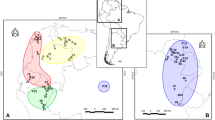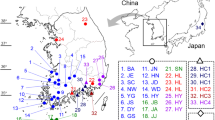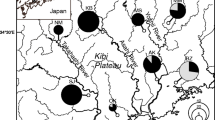Abstract
Hydrochoerus hydrochaeris is an herbivorous rodent that inhabits most wetlands of South America. It is a well-known species, but studies about their population genetics are scarce. The aim of this study was to analyze the genetic diversity, population genetic structure and historical population dynamics of the species in the Chaco-pampean region, using mitochondrial DNA control region sequences and a non-invasive sampling design. Our results showed the existence of four haplogroups in the study area. Haplogroup I is composed by individuals from most of the study area, while the remaining include individuals from some sites in Paraguay (haplogroups III and IV) or Argentina (haplogroup II). The genetic diversity was low in haplogroups I, III and IV. Our results suggest that the Paraná and Paraguay rivers would be acting as a migration corridor for the species. Historical population dynamics analyses and haplotype network showed past population expansions and secondary contact between haplogroups I–II and I–IV, which could be related to past climatic events such as the Iberá Wetlands formation. These results must be taken as working hypotheses for future studies about the population genetics of capybara and related species inhabiting the region.
Similar content being viewed by others
References
Allendorf, F.W., Luikart, G.H., Aitken, S.N., 2013. Conservation and the Genetics of Populations, second ed. Willey-Blackwell, Oxford.
Alvarez, M., Kravetz, F.O., 2004. Propuesta de aprovechamiento sustentable del carpincho (Hydrochoerus hydrochaens, Rodentia) en Argentina. Libro de Resúmenes VI Congreso Internacional sobre Manejo de Fauna Silvestre en la Amazonia y Latinoamérica, 406–414.
Arzamendia, V., Giraudo, A.R., 2012. A panbiogeographical model to prioritize areas for conservation along large rivers. Divers. Distrib. 18, 168–179.
Avise, J.C., 2004. Molecular Markers, Natural History, and Evolution, second ed. Sinauer Associates Inc., Sunderland.
Bandelt, HJ., Forster, P., Rohl, A., 1999. Median-joining networks for inferring intraspecific phytogenies. Mol. Biol. Evol. 16, 37–48.
Bolkovic, M.L., Quintana, R.D., Ramadori, D., Elisetch, M., Rabinovich, J., 2006. Proyecto Carpincho. Propuesta para el uso sustentable del Carpincho (Hydrochoerus hydrochaerii) en la Argentina. In: Bolkovic, MX., Ramadori, D. (Eds.), Manejo de Fauna Silvestre en la Argentina, Programas de uso sustentable, Dirección de Fauna Silvestre. Secretaria de Ambiente y Desarrollo Sustentable, Buenos Aires, pp. 105-199.
Borges-Landáez, P.A., Perdomo, G., Herrera, E.A., 2012. Estructura y diversidad genética en poblaciones manejadas de Chiguire en los Llanos Venezolanos. Interciencia 37, 227–233.
Brea, M., Zucol, A.F., 2011. The Parana-Paraguay Basin: geology and paleoenvironments. In: Albert, J.S., Reis, R.E. (Eds.), Historical Biogeography of Neotropical Freshwater Fishes. University of Californa Press, California, pp. 69–87.
Bücher, E.H., Huszar, P.C., 1999. Sustainable management of the Gran Chaco of South America: ecological promise and economic constraints. J. Environ. Manage. 57, 99–108.
Byrne, M.S., Quintana, R.D., Bolkovic, M.L., Cassini, M.H., Túnez, J.I., 2015. The role of river drainages in shaping the genetic structure of capybara populations. Genética, 645–656.
Campos-Krauer, J.M., Wisely, S.M., 2010. Deforestation and cattle ranching drive rapid range expansion of capybara in the Gran Chaco ecosystem. Glob. Change Biol., 1–13.
Colin, A.C., 1991. Reproductive biology of captive capybara. J. Mammal. 72, 206–208.
Corander. J., Tang, J., 2007. Bayesian analysis of population structure based on linked molecular information. Math. Biosci. 205, 19–31.
Corander. J., Waldmann, P., Sillanpãã, M.J., 2003. Bayesian analysis of genetic differentiation between populations. Genetics 163, 367–374.
Corander, J., Marttinen, P., Siren, J., Tang, J., 2008. Enhanced Bayesian modelling in BAPS software for learning genetic structures of populations. BMC Bioinformatics 9, 539.
Drummond, A.J., Rambaut, A., 2007. BEAST: bayesian evolutionary analysis by sampling trees. BMC Evol. Biol. 7, 214.
Drummond, A.J., Suchard, M.A., Xie, D., Rambaut, A., 2012. Bayesian phylogenetics with BEAUti and the BEAST 1.7. Mol. Biol. Evol. 29, 1969–1973.
Dutech, C. Joly, H.I., Jarne, P., 2004. Gene flow, historical population dynamics and genetic diversity within French Guianan populations of a rainforest tree species, Vouacapoua americana. Heredity 92, 69–77.
Excoffier, L., Lischer, H.E.L., 2010. Arlequin suite ver 3.5: a new series of programs to perform population genetics analyses under Linux and Windows. Mol. Ecol. Resour. 10, 564–567.
Excoffier, L., Smouse, P., Quattro, J., 1992. Analysis of molecular variance inferred from metric distances among DNA haplotypes: application to human mitochondrial DNA restriction data. Genetics 131, 479–491.
Fernandez Pacella, L., Garralla, S., Anzótegui, L., 2011. Câmbios en la vegetación durante el Holoceno en la region Norte del Ibera, Corrientes. Argentina. Rev Biol Trop. 59, 103–112.
Frankham, R.J., Bailou, J.D., Briscoe, D.A., 2010. Introduction to Conservation Genetics, second ed. Cambridge University Press, Cambridge.
Freeland, J.R., 2005. Molecular Ecology. Wiley, Chichester.
Fu, Y.X., 1997. Statistical tests of neutrality of mutations against population growth, hitchhiking and background selection. Genetics 147, 915–925.
Giorgis, M.A., Lopez, MX., Rivero, D., Cingolani, A.M., 2015. Câmbios climáticos en las sierras de Córdoba (Argentina) durante el Holoceno. Aportes a las reconstrucciones climáticas a través del análisis de silicofltolitos del sitio arqueológico El Alto 3. Boi. Soe. Argent. Bot. 50, 361–375.
Grau, H.R., Torres, R., Gasparri, N.I., Blendinger, P.G., Marinaro, S., Macchi, L., 2015. Natural grasslands in the Chaco. A neglected ecosystem under threat by agriculture expansion and forest-oriented conservation policies. J. Arid Environ. 123, 40–46.
Haig, S.M., 1998. Molecular contributions to conservation. Ecology 79, 413–425.
Hamilton, M.B., 2009. Population Genetics. Wiley-Blackwell, Hong Kong.
Harpending, H.C., 1994. Signature of ancient population growth in a low-resolution mitochondrial DNA mismatch distribution. Hum. Biol. 66, 591–600.
Haiti, D., Clark, A., 1997. Principles of Population Genetics, third ed. Sinauer Associates, Sunderland.
Herrera, E.A., Macdonald, D.W., 1989. Resource utilization and territoriality in group-living Capybaras (Hydrochoerus hydrochaens). J. Anim. Ecol. 58, 667–679.
Ho, S.Y.W., Shapiro, B., 2011. Skyline-plot methods for estimating demographic history from nucleotide sequences. Mol. Ecol. Resour. 11, 423–434.
Kandus, P., Malvárez, A.I., 2002. Las islas del Bajo Delta del Paraná. In: Borthagaray, J.M. (Ed.), El Rio de la Plata como território. Ediciones FADU, FURBAN e Infinito
Buenos Aires. Kumar, S., Stecher, G., Tamura, K., 2016. MEGA7: molecular evolutionary genetics analysis version 7.0 for bigger datasets. Mol. Biol. Evol. 33, 1870–1874.
Lacy, R.C., 1997. Importance of genetic variation to the viability of mammalian populations. J. Mammal. 78, 320–335.
Librado, P., Rozas. J., 2009. DnaSP v.5: a software for comprehensive analysis of DNA polymorphism data. Bioinformatics 25, 1451–1452.
Lopes, I.F., Brito, RA, Henrique-Silva, F.H., Del Lama, N.S., 2006. Demographic history of wood stork (Myctena americana) Brazilian Pantanal colonies revealed by mitochondrial DNA analysis. Genet. Mol. Biol. 29, 241-250.
Lopes, I.F., Mino, CL, Del Lama, S.N., 2007. Genetic diversity and evidence of recent demographic expansion in waterbird populations from the Brazilian Pantanal. Braz. J. Biol. 67, 849–857.
Luck, G.W., Daily, G.C., Ehrlich, P.R., 2003. Population diversity and ecosystem services. Trends Ecol. Evol. 18, 331–336.
Marquez, A., Maldonado, J.E., Gonzalez, S., Beccaceci, M.D., Garcia, J.E., Duarte, J.M.B., 2006. Phylogeography and Pleistocene demographic history of the endangered marsh deer (Biastocenis dichotomus) from the Rio de la Plata Basin. Conserv. Genet. 7, 563–575.
Mercer, J.H., 1976. Glacial history of southernmost South America. Quat. Res. 6, 125–166.
Milá, B., Girman, D.J., Kimura, M., Smith, T.B., 2000. Genetic evidence for the effect of a postglacial population expansion on the phylogeography of a North American songbird. Proc. Biol. Sci. 267, 1033–1040.
Mills, L.S., Smouse, P.E., 1994. Demographic consequences of inbreeding in remnant populations. Am. Nat. 144, 412–431.
Nei, M., 1987. Molecular Evolutionary Genetics. Columbia University Press, New York.
Nowak, R.M., 1991. Walker’s mammals of the world. In: Johns Hopkins, fifth ed. University Press, Baltimore.
O’Grady, J.J., Brook, B.W., Reed, D.H., Bailou, J.D., Tonkyn, D., Frankham, R., 2006. Realistic levels of inbreeding depression strongly affect extinction risk in wild populations. Biol. Conserv. 133, 42–51.
Oakley, L.J., Prado, D., Adámoli, J., 2005. Aspectos Biogeográficos del Corredor Fluvial Paraguay- Paraná. Insugeo, Miscelânea 14, 245–258.
Orfeo, O., Neiff, J.J., 2008. Esteros dei Ibera: un enorme laboratório a cielo abierto. Instituto de Geologia y Recursos Minerales, Servido Geológico Minero Argentino, Buenos Aires, pp. 415–425.
Paschoaletto, K., Ferraz, M., Lechevalier, M., Zarate di Couto, H., Martins, L., 2003. Damage caused by capybaras in a corn held. Sci. Agric. 60, 191–194.
Posada, D., 2008. JModelTest phylogenetic model averaging. Mol. Biol. Evol. 25, 1253–1256.
Posada, D., Crandall, K.A., 1998. MODELTEST: testing the model of DNA substitution. Bioinformatics 14, 817–818.
Quintana, R.D., 1999. Relationship between a wetland landscape structure and wildlife: the capybara (Hydrochoeris Hydrochoeris) as a study case. In: Malvarez, A.I. (Ed.), Tópicos sobre humedales subtropicales y templados de Sudamérica. ORCyT-MAB/UNESCO, Montevideo, pp. 185–204.
Quintana, R.D., Bó, R., Kalesnik, F., 2002. La vegetación y la fauna silvestres de la porción terminal de la cuenca del Plata. In: Bortharagay, J.M. (Ed.), Consideraciones biogeográficas y ecológicas. El Rio de la Plata como território. Universidad de Buenos Aires y Ediciones Infinito, pp. 99–124. Ringuelet, RA, 1961. Rasgos fundamentales de la Zoogeografía de la Argentina. Physis 22, 151–170.
Rogers, A.R., 1995. Genetic evidence for a Pleistocene population expansion. Evolution 494, 608–615.
Rogers, A.R., Harpending, H., 1992. Population growth makes waves in the distribution of pairwise genetic differences. Mol. Biol. Evol. 9, 552–569.
Ruiz-Garria, M., Luengas-Villamil, K., Pinedo-Castro, M., Leal, L., Bernal-Parra, L.M., Shostell, J.M., 2016. Continuous Miocene, Pliocene and Pleistocene influences on mitocondrial diversification of the Capybara (Hydrochoerus hydrochaeris;Hydrochoeridae, Rodentia): incapacity to determine exclusive hypotheses on the origins of the Amazon and Orinoco diversity for this species. J. Phytogen Evol. Biol. 4 (2), 1–20, http://dx.doi.org/10.4172/2329-9002.1000166.
Schivo, F., Kandus, P., Bolkovic, M.L., Gail Minotti, P., Gonzalez Trilla, G., Quintana, R.D., 2015. A habitat suitability model for capybara (Hydrochoerus hydrochaens) at its core area in Argentina. Trop. Conserv. Sci. 8, 150–168.
Slatkin, M., 1993. Isolation by distance in equilibrium and non-equilibrium populations. Evolution 47, 264–269.
Tajima, F., 1983. Evolutionary relationship of DNA sequences in finite populations. Genetics 105, 437–460.
Tajima, F., 1989. Statistical method for testing the neutral mutation hypothesis by DNA polymorphism. Genetics 123, 585–595.
Werle, E., Schneider, C., Renner, M., Völker, M., Fiehn, W., 1994. Convenient single-step, one tube purification of PCR products for direct sequencing. Nucleic Acids Res. 22, 4354–4355.
Wright, S., 1931. Evolution of Mendelian populations. Genetics 16, 97–159.
Author information
Authors and Affiliations
Corresponding author
Rights and permissions
About this article
Cite this article
Byrne, S., Quintana, R.D., Bolkovic, M.L. et al. Population genetics of the capybara, Hydrochoerus hydrochaeris, in the Chaco-pampean region. Mamm Biol 96, 14–22 (2019). https://doi.org/10.1016/j.mambio.2019.03.008
Received:
Accepted:
Published:
Issue Date:
DOI: https://doi.org/10.1016/j.mambio.2019.03.008




